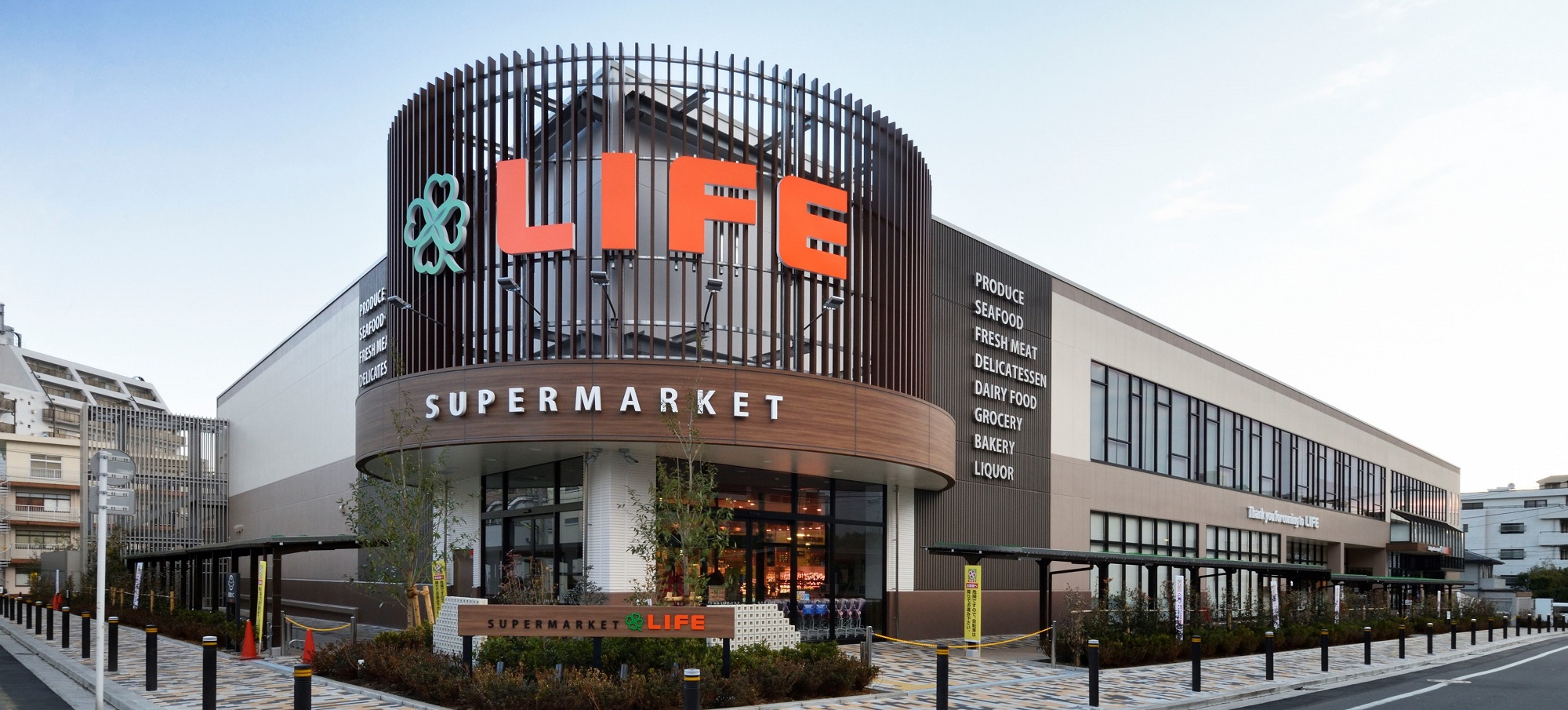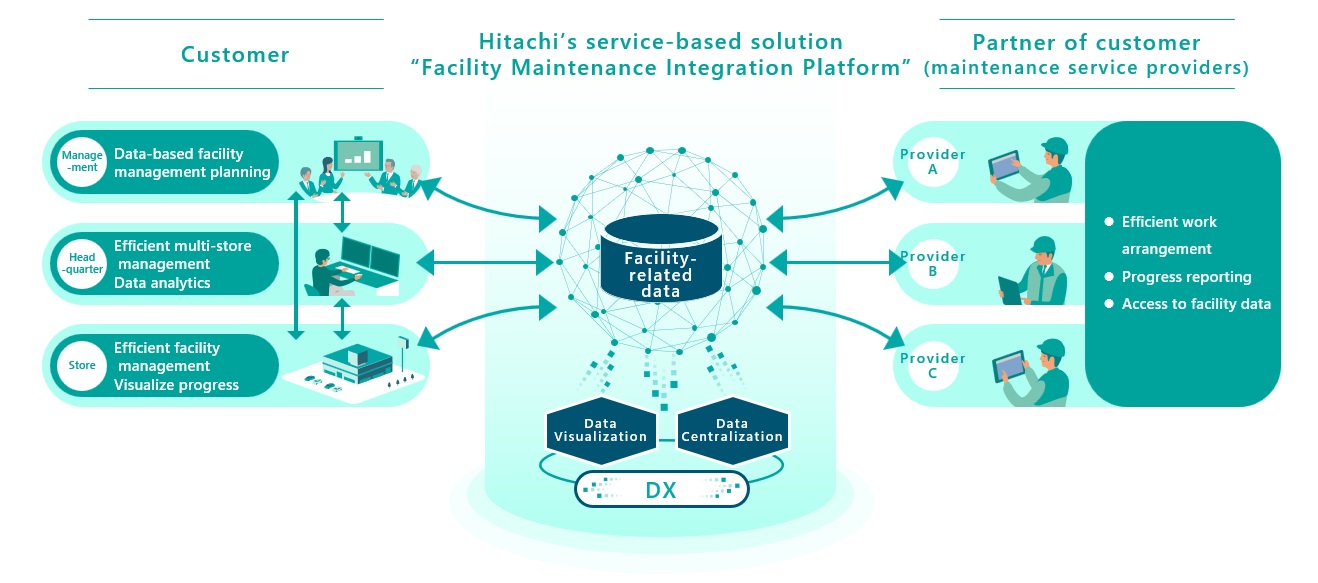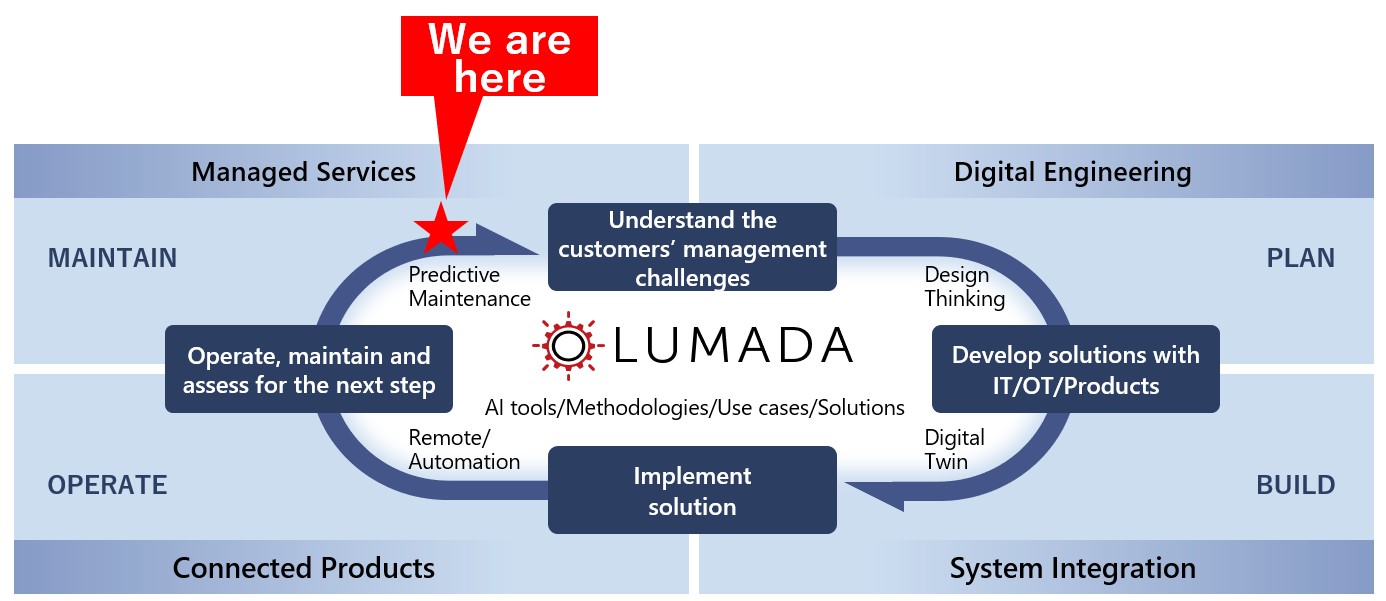
Hitachi, Ltd. provides LIFE CORPORATION which operates the LIFE supermarket chain in the Tokyo Metropolitan and Kinki areas, with a facility maintenance integration platform, a cloud service streamlining maintenance operations and optimizing operational plans by centralizing and visualizing equipment-related data. The service uses digital technologies to support facility management and enables the analysis of accumulated data and its utilization in management decision making.
One and a half years have passed since the service was launched in September 2023. Initially it was limited to 144 supermarkets in the Tokyo Metropolitan Area, and it has currently expanded to all of the stores including those in the Kinki region. With this in mind, what effects has the service had and what possibilities are we beginning to see? We interviewed Mr. Masaaki Terada, who is the deputy section head of LIFE CORPORATION's Metropolitan Facility and Procurement Department, and Mr. Hiroto Suzuki who works in the Energy Collaborative Creation Center's Department 1 within the Energy Systems Sales & Marketing Group of Hitachi, Ltd. Mr. Terada is involved in facility management and Mr. Suzuki supervised the development and provision of the service.

Mr. Masaaki Terada, LIFE CORPORATION (left) and Hiroto Suzuki, Hitachi, Ltd. (right)
LIFE CORPORATION, a major retailer, operates 314 LIFE supermarkets in the Tokyo Metropolitan and Kinki areas as of February 2025. The company’s efforts to establish unique community-based stores in pursuit of being Japan’s no. 1 supermarket chain that is trusted by customers, employees and society have been greatly supported by consumers and their sales have continued to increase. LIFE CORPORATION’s operating income in FY2023 was larger than that of any other company in the supermarket industry.
Regarding LIFE CORPORATION's philosophy, Mr. Terada, the deputy section head of their Metropolitan Facility and Procurement Department, said,
“Our mission is to support local lifelines, and we are committed to stably operating stores which are a part of the infrastructure supporting local communities. The Metropolitan Facility and Procurement Department is responsible for the overall maintenance and management of the supermarket facilities. Freezers and refrigerators for displaying merchandise, air-conditioners, plumbing, lighting, automatic doors and all other equipment is within the scope of management. This equipment must operate without problems so that the supermarket can play its role as a part of the infrastructure for living and help customers enjoy shopping and be comfortable while doing so. If something malfunctions, the equipment must be repaired as quickly as possible. First, we have always wanted to reduce the number of problems that occur,” Mr. Terada explained.
Previously, LIFE CORPORATION outsourced administrative operations. When equipment malfunctioned, the store would report it to the outsourcee’s call center which would communicate the report to the administrative outsourcee. The quote for the repair submitted by the outsourcee would be approved by the Facility and Procurement Department before the repair is conducted.
“If we follow these steps, we wouldn’t be able to learn all of the details such as which equipment has been repaired or how much the individual repairs cost, partly because we didn't have enough resources. In fact, we were not able to analyze or utilize malfunction data in-house, so we began to consider switching to the in-house management of maintenance operations and the use of the data when making management decisions. This was in about 2018 or 2019. However, we had no system for organizing historical data or storing it with data we would collect in the future. We had no IT system to keep this data in-house. This is why we sought the advice of Hitachi,” Mr. Terada recalls.

Mr. Masaaki Terada
the deputy section head, Metropolitan Facility and Procurement Department, LIFE CORPORATION
Mr. Terada’s department sought advice regarding the streamlining of facility maintenance from Hiroto Suzuki, who works in the Energy Collaborative Creation Center's Department 1, Energy Systems Sales & Marketing Group of Hitachi, Ltd.
“We asked what problems LIFE CORPORATION was experiencing regarding maintenance management. I thought that EFaaS, which Hitachi had begun to commercialize in around 2019, could help solve the problem.”
Energy and Facility Management as a Service, or EFaaS, is a business model of providing both energy management services that visualize energy usage to support optimal operations and facility management services supporting the entire lifecycle of facilities from installation to management and operation. In terms of energy management, EFaaS contributes to the promotion of energy-saving activities and carbon neutrality. Regarding facility management, it helps the customers involved in the operation of equipment, the management of maintenance and other activities to reduce the labor and expenses necessary. EFaaS offers solutions that flexibly cater to customers’ needs. It may be used in situations such as when Hitachi provides maintenance management services including the provision of the facility, or when the customer owns the facility and Hitachi provides maintenance management services.
“This was when Hitachi was solidifying its concept for EFaaS operations. In this context, we began to discuss what kinds of solutions would be needed to solve the problems that LIFE CORPORATION was facing. Since the Hitachi Group has many solutions, however, it took a lot of time to understand each of the problems and identify the optimal solutions for the problems. In addition to solving the problems at that time, we also needed to consider scalability in terms of, for example, the expansion of the scope of application, the addition of functions and connections to other systems. This increased the difficulty of the job,” Mr. Suzuki said. He recalls an extended trial and error process leading up to the selection of solutions.
After very active discussion, the facility maintenance integration platform was launched in September 2023. The service is intended to streamline maintenance management and optimize operational plans by centralizing and visualizing them using a cloud-based platform, with all data on maintenance divided for all of the different pieces of equipment, such as freezers, refrigerators and air-conditioners.

Conceptual rendering of the facility maintenance integration platform
After the service was launched, a flow for the automation and sharing of maintenance management tasks was established to streamline facility maintenance: When equipment malfunctions, enter information about the equipment in the platform at the store and notifications are automatically sent to the head office and the partner company in charge of maintenance. Then the partner company accesses the platform to check the details of the situation and handle it. Quotes for repair expenses, actual expenses and repair details can be shared with the store and the head office and the data is automatically centralized and stored when the facility company enters the data in the platform.
Using the platform, people involved in maintenance management tasks, including business partners repairing equipment, people working in stores, the administrative division and executives use a common system to perform facility management and other tasks, including ordering repairs, thereby dramatically increasing the cooperation of the people in the tasks so that their actions are more accurate and faster.
The platform makes it possible to centralize information from multiple facilities at the head office and monitor the progress of multiple individual repair projects on the same system, making comprehensive management possible. This involves sharing resources between stores and identifying and solving bottleneck to enable facilities to quickly recovery from equipment failures and other problems. Additionally, accumulating information about issues such the operation and repair histories of equipment and records of transaction with and quotes from facility management companies makes it possible to formulate accurate and cost-effective operational plans, such as plans for accurately and promptly identifying malfunction-prone stores and facilities.
Explaining the impact of the platform, Mr. Terada explains, “In the 144 stores there is an average of 850 malfunctions a month and about 10,000 malfunctions a year. Automating the notices and the accumulation of data makes it possible to streamline facility maintenance. Gradually, stores' awareness of the maintenance situation has changed because the head office’s administrative division, store managers and numerous partner companies are now able to share information about the details of repairs, expenses and other issues on a shared platform. Previously, we tended to leave the handling of malfunctions to the head office, but it appears that the visualization of the details of repairs has been increasing our motivation to do the things that we can do.”
It has been more than a year and a half since the platform was initially introduced, and it has been expanded from 144 stores in the Tokyo Metropolitan Area to all stores, including those in the Kinki region. LIFE CORPORATION has accumulated data that will be the foundation of its facility management activities. Mr. Terada went on to share a plan to put more effort into analytics in the future based on this information.
Speaking on his expectations, he said, “It has become possible to, for example, compare electricity bills before and after the replacement of equipment, the number of times that specific manufacturers' equipment malfunctions and equipment maintenance costs. This also makes it possible for the head office to recommend devices in view of lifecycle costs when choosing equipment when opening a new store or replacing equipment. When doing this in the past, all the head office did was approve plans that were submitted to it. By accumulating facility maintenance data and analyzing it, we will also optimize the timing of facility maintenance and renovation activities.”

A view of a supermarket sales floor
At the same time, the value provided by the facility maintenance integration platform is more than just the optimization of facility maintenance and the utilization of related data, Mr. Suzuki said.
“By forming digital connections between the store employees that normally use these facilities, the numerous partner companies involved in equipment and maintenance and the head office administrative department, the solution increases information sharing, facilitates people's referencing of information and increases the amount of information available when making decisions during on-site operations. This enables LIFE CORPORATION and partner companies to assist the frontline workers that support worksites and enhance the quality and productivity of operations, including facility maintenance operations.”
As the labor shortage becomes more severe, it will become increasingly important for companies supporting the infrastructure for living, such as distributors and retailers, to reduce the burdens on workers at their worksites. While many of the jobs done by frontline workers can only be performed by humans, the initial use of digital technologies in areas such as the linkage and utilization of facility management data is a foothold beginning the digital transformation (DX) of operations to increase the efficiency of worksites.
Foreseeing this future, Mr. Terada said, “This platform is indispensable in our reform of our operations, and I want to thank Hitachi for developing it. Going forward the linkage between products and the utilization of facility maintenance data will be expanded. In this way, we will hopefully start our DX beginning with the facility division and contribute to increasing the quality of our operations and business management.”
With solutions, services and technologies using the latest digital technologies, Hitachi focuses on the Lumada business to accelerate the DX of companies and society. The Lumada business is divided into four categories in conjunction with the cycle of collaborative creation with customers. Managed services is the category that facility maintenance integration platforms fall under.

Where we are currently in Lumada cycle
The realization of a society where sustainability and each individual’s wellbeing are in balance is something that Hitachi aims to achieve, and to do so, it is necessary to promote DX together with customers. Mr. Suzuki explained that the future prospects of the facility maintenance integration platform are a part of the above efforts. “Going forward, we will implement a cycle of discussing and implementing solutions to emerging problems that are visualized using the accumulated facility maintenance data linked to other data. First, we will talk with LIFE CORPORATION with a view toward expanding the scope of the platform from store facility management to energy management, contributing to the reduction of CO2 emissions using power consumption and other data from each store and facility.
He then concluded the interview as follows.
“As the solution is referred to as a platform, it has the potential to, in addition to facilitating facility and energy management, be a foundation supporting management infrastructure in conjunction with the operations and management-related information. By expanding the solution, we will support the DX of LIFE CORPORATION. It is also designed to be rolled out to other distributors, retailers and industries, and we are seeking to introduce many customers to the facility management platform. Our future goal is to contribute to solving social issues such as the labor shortage and decarbonization by utilizing data related to facility management and supply chains across different regions and industries by implementing AI technologies and other means."

LIFE CORPORATION(link: http://www.lifecorp.jp/)
The company operates the LIFE supermarket chain in the Kinki and Kanto areas. Based on in its “make daily shopping convenient and happy” concept, LIFE CORPORATION operates a variety of community- and people-based businesses. For example, the company opens stores that cater to customers’ needs such as the need for community-based information sharing and stores that are people-friendly and environmentally friendly, develops original branded merchandise and expands its online supermarket business.